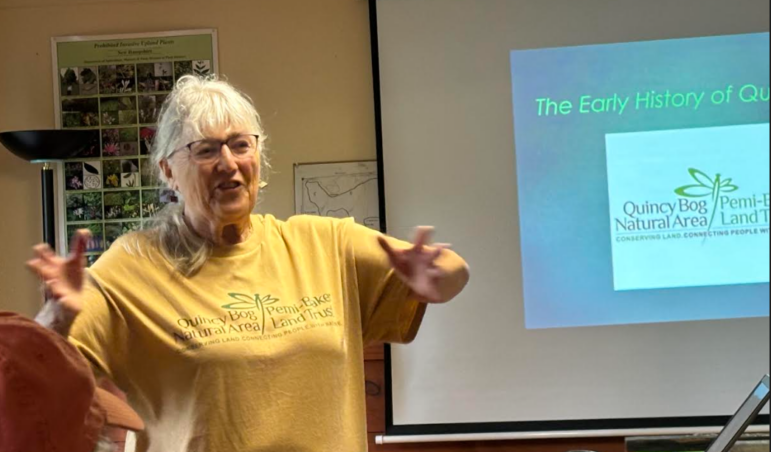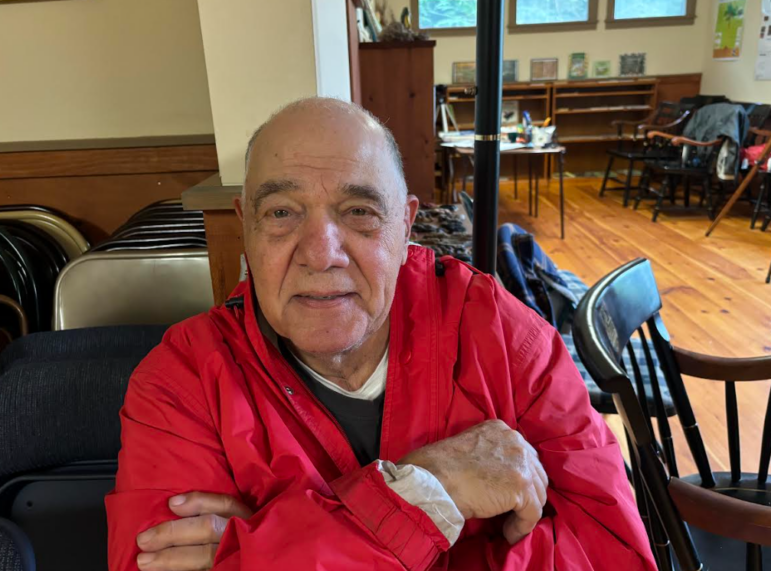
Betty Jo Taffe tells the story of the Quincy Bog in Rumney. Paula Tracy photo
By PAULA TRACY, InDepthNH.org
RUMNEY – A conservation story more than 50 years in the making began with a loud “bang” that echoed through the Baker River Valley and sent neighbors off their porches and into action.
That action continues today and not much has changed, including the beavers.
At the Quincy Bog Natural Area Saturday, the story was told and cake was enjoyed at the bog’s 50th anniversary open house, marking an amazing story of community can-do, which began with a developer trying to blow up dams to drain the wetlands.
Longtime Selectman Bob Berti was there to hear the tale told by his neighbor, Betty Jo Taffe, and recalls that evening, the sound of an explosion followed by another on Aug. 11, 1970.

Longtime Rumney selectman Bob Berti. Paula Tracy photo
The Coffin brothers, John and Charlie, heard it too and went out to find out what the sound was. They discovered that a developer had blasted two beaver dams in an effort to drain what was then known as the Cranberry Bog for development.
That action set in motion a group, led by the late Retired Air Force Col. George N. “Joe” Kent, a fellow neighbor and others, who in 1974, established Rumney Ecological Systems which owns and protects the bog.
They convinced the developer, through a bit of evidence-based strong-arming, to sell the bog to the non-profit for a bargain price of $10,000 rather than try to build more house lots off Quincy Road.
Today, the Quincy Bog https://quincybog.org/ offers opportunities for free outdoor education, recreation, and land protection with its trails encircling the ancient peat bog with its glacial ledges, mountain views and rimmed with pines, which draw wildlife of all kinds and dogs on leashes with their people.
And the beavers, “nature’s engineers” as Taffe noted, have endured and still run the show.
“Fifty years later we have the same mission of protecting land and connecting people with nature,” she said. “We are still an all volunteer organization offering trails, nature walks, school programs, a summer series of evening programs, student interns and our Bog Notes newsletter, interpretative materials as well. But no more annual dinners or African safaris,” she said to the laughter of the group which gathered to mark the occasion, after she noted that there were fundraising efforts which included a 19-day safari.
“We are still supported primarily by individuals and some businesses and then occasional grants for special projects like trail and bridge construction and we still have the same nature center,” she said.
“We are able to continue offering a lot of the things that Joe and his followers offered 50 years ago,” Taffe noted.
Her slide show presentation included a description of what the bog looked like during the Ice Age, how it was later used by native Americans and colonial settlers who followed trappers interested in the beaver hide for the European hat market.
She said the unregulated trapping killed out the species from most of the state only to be reintroduced by an effort to return the beaver to their former colonies.

The Quincy Bog center in Rumney. Paula Tracy photo
Back then, the smart furbearers were a form of currency and many people were in the business of hunting them.
In some parts of New Hampshire, the beaver were extirpated by 1715 and given complete protection by 1905 but it was too late, wrote Helenette Silver in her 1957 book “History of New Hampshire Fish and Game Furbearers.”
The last family of about 12 beavers was found in Coos County and in 1912 NH Conservation Officer Harry Hurlburt was guiding in Coos County on Cedar Stream near the headwaters of the Swift Diamond when he came upon them.
Protected as an endangered species by the state, the colony grew in size and in 1926 Conservation Officer Perley Terrill trapped four and transported them to Ellsworth Three Ponds north of Plymouth and about five miles from the Quincy Bog, the book indicates. Other colonies were created in Middleton after the creatures were on display at the Rochester Fair, Silver notes.
More relocations occurred and by 1940 it was estimated there were 7,000 beavers in the state.
Fast forward to the 1960s and the industrious beavers had created dams at the bog to hold back the water from streams because they do better in deep water than walking on land, Taffe said. There are currently about seven lodges on the Bog and half are active.
“Everything changed in the 1970s,” Taffe said.
Then, Quincy Road resident Phillip Comeau sold 65 acres of wetlands and upland forest including the bog, to Stanley Shmishkiss. Another industrious type like the beaver, Shmishkiss, whom Taffe said Kent described as a “hard-headed businessman with an environmental quotient of zero, albeit a nice guy.”
Within a short time of the sale to Shmiskiss, bulldozers were used to start creating a number of house lots near the bog.
“One evening when John Coffin was sitting in his kitchen…he heard blasting coming from the direction of the bog, so he went and got his brother Charlie, who lived next door and discovered that two beaver dams had been blasted,” Taffe said.
Together, they decided to go to speak to Kent, who had a way of getting things done. Kent wrote articles in local and state newspapers, went to town hall and the Planning Board which resulted in the chair of the board, Bob Berti, taking action.
Berti recalled the state Department of Transportation got involved because the explosion almost caused the state to lose Quincy Road.
The Audubon Society of New Hampshire, the Society for the Protection of NH Forests and other conservation groups were also notified about the destruction of the wetlands.
Bog coring and botanical studies on either side of the developer’s access road had found the road had penetrated the wetlands, and the findings were shared with the Planning Board, Conservation Commission and the developer “and bulldozing was stopped.”
Shmishkiss put 40 acres on the market “but who is going to buy the property and how would they raise the money?” Taffe asked the group.
Kent began a writing campaign to the Plymouth Record Enterprise and the Manchester Union Leader and by 1974 he and other locals formed the conservation group with an aim to particularly use the land to educate local school children about nature.
The group was able to get the developer to sell the bog and he was willing to offer them a mortgage at a low rate and even served on the board of trustees. Taffe said he also paid one third of the payments on the mortgage.
“A good guy, he was,” she said.
Over the years, the group with the help of the Jaycees built a small cabin to hold its ecological books and treasures and conduct educational classes, in 1978. In 1993 the group was able to get the Student Conservation Corps to build a trail around the bog. Efforts to build a bridge have been impacted by both beaver activity and a hurricane over the years but a floating bridge now works to connect the trails at its outlet.
At the end of the celebration the group dedicated the trails to both Berti and Betty Jo Taffe and her late husband and bog supporter, Bill Taffe.
A copy of the bog notes describing the story by Taffe is at:
https://quincybog.org/wp-content/uploads/2024/01/BogNotes_Winter23_24-ColorVersion.pdf
The bog hosts free Wednesday evening programs in the summer months at 7 p.m. with guest speakers this summer including birder and Executive Director of the Squam Lakes Natural Science Center of New Hampshire Iain MacLeod July 24 and poet Jeffrey Zygmont June 26 on Robert Frost, among others.
There are also weekend events, nature walks and workshops offered.
Tripadvisor offers tips on how to get to the bog, what the trails are like and more information at https://www.tripadvisor.com/Attraction_Review-g46215-d3549959-Reviews-Quincy_Bog_Natural_Area-Rumney_New_Hampshire.html





